




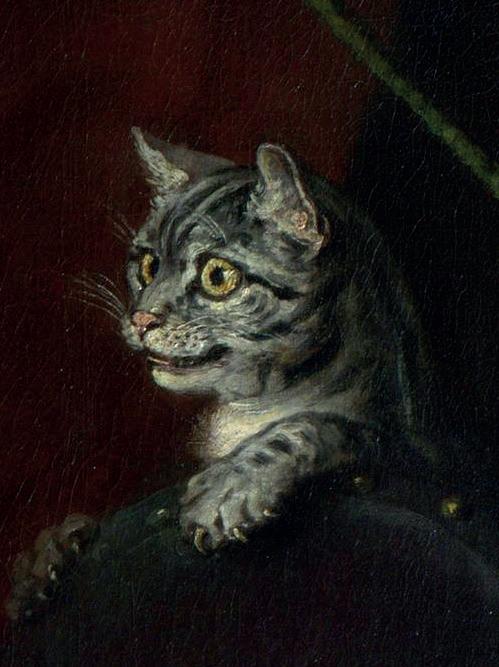
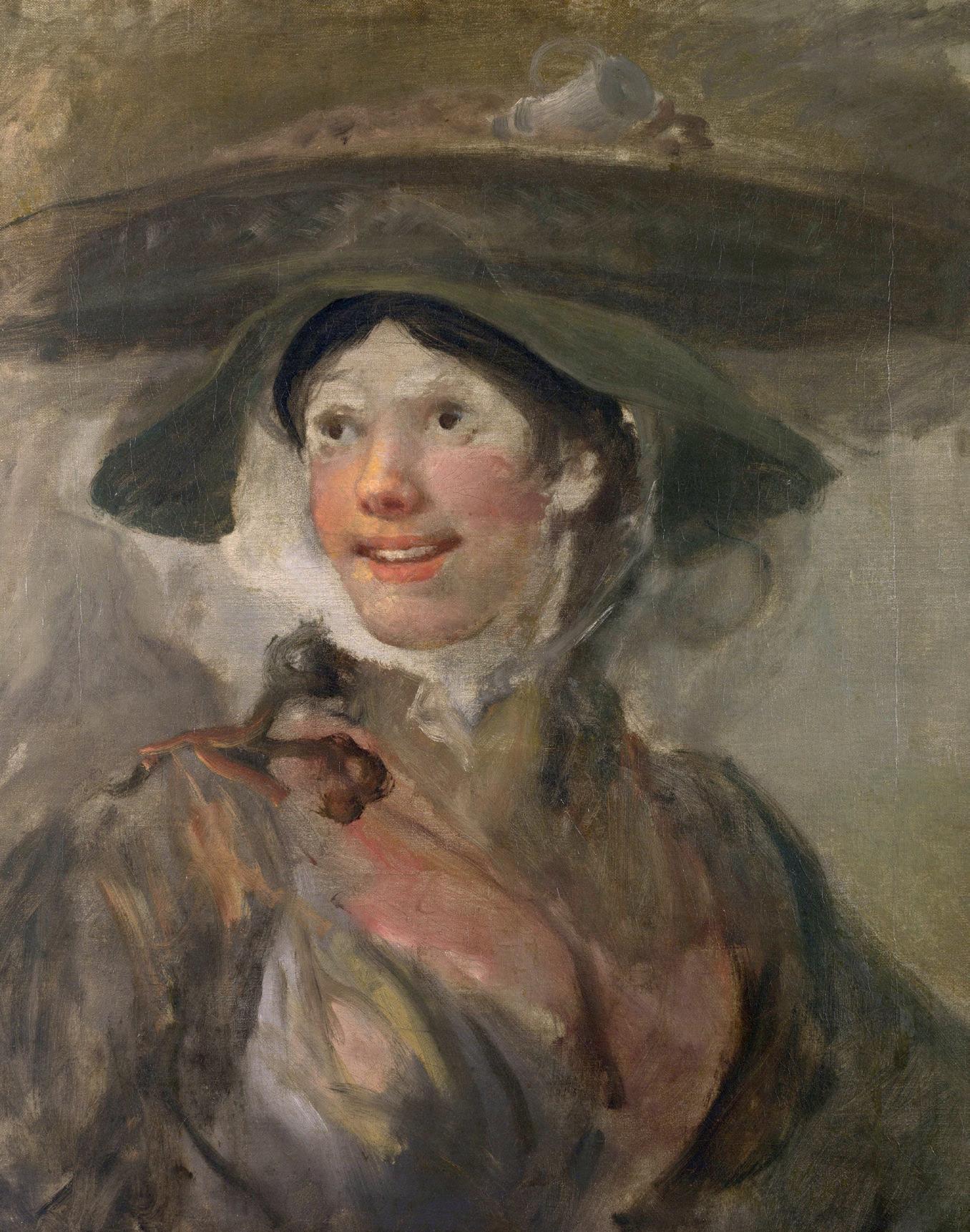

introduced by MARTIN MYRONE

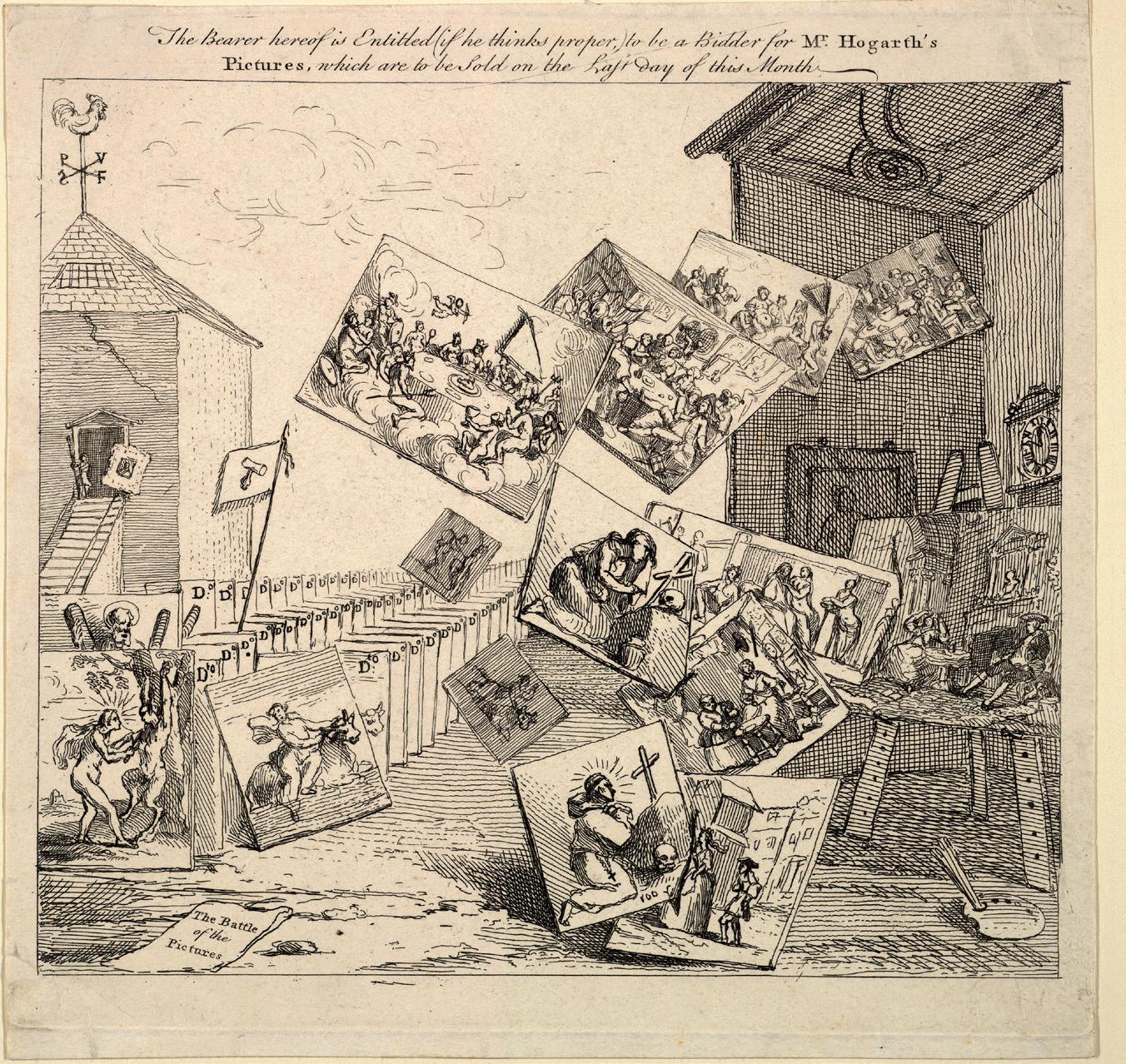
The Battle of the Pictures, 1745
This image of Hogarth’s paintings fighting with assorted Old Masters was issued by him as a bidder’s ticket to an auction of his works

Introduction
p. 7
Anecdotes of William Hogarth, by himself
Edited by John Ireland
Chapter 1, p. 27
Chapter 2, p. 39
Chapter 3, p. 65
Chapter 4, p. 95
Chapter 5, p. 107
Remarks on various prints, by William Hogarth
Edited by John Ireland p. 129
Remarks on Marriage A-la-Mode, by William Hogarth
Edited by John Ireland, with further explanations by Thomas Clerk p. 155
List of illustrations p. 189
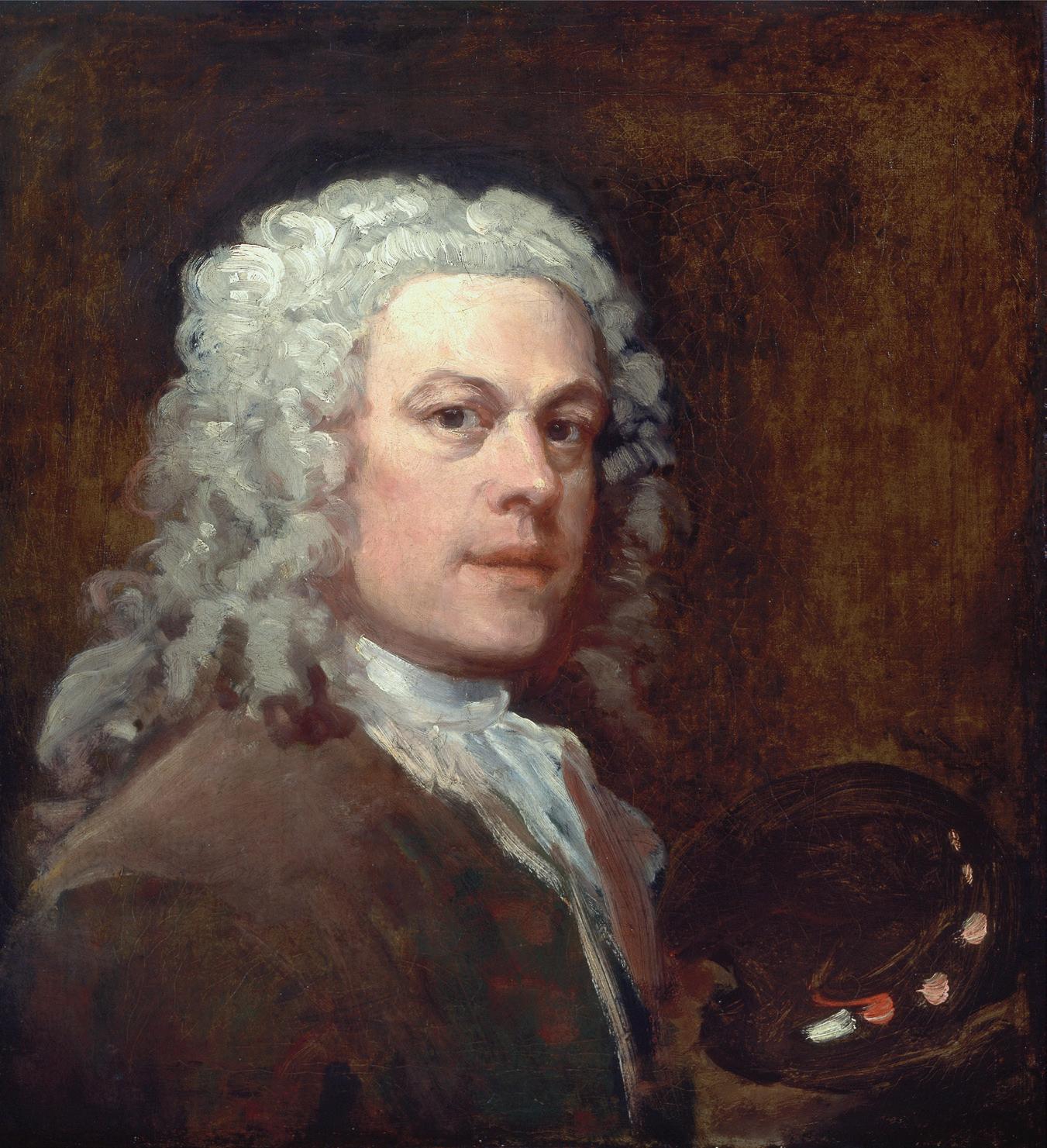

martin myrone
‘ shifting for myself’: hogarth ’ s progress
‘There is some’, observed Hogarth, in amongst the mass of reflections and notes drawn up late in life, from which his editor John Ireland extracted the autobiography republished here. ‘There is something’, he meant to write, for those notes are rough drafts, ‘so bewitching in these arts that in spite of poverty there will always be too many Poets and Painters’. On the same sheet Hogarth calculated that there could never be ‘More than three History painters or as many statuarys’ that ‘can be supported in this country’, and that ‘if we have three lanskip painters they barely live’. He was writing from experience: ‘in my time I have known three most excellent superior painters, all of [them] extremely industrious’, yet all of whom struggled, and ‘two of them dyed in great poverty’. Penned in the last years of his life, these were the
Opposite: Self-portrait, c. 1735 (unfinished)
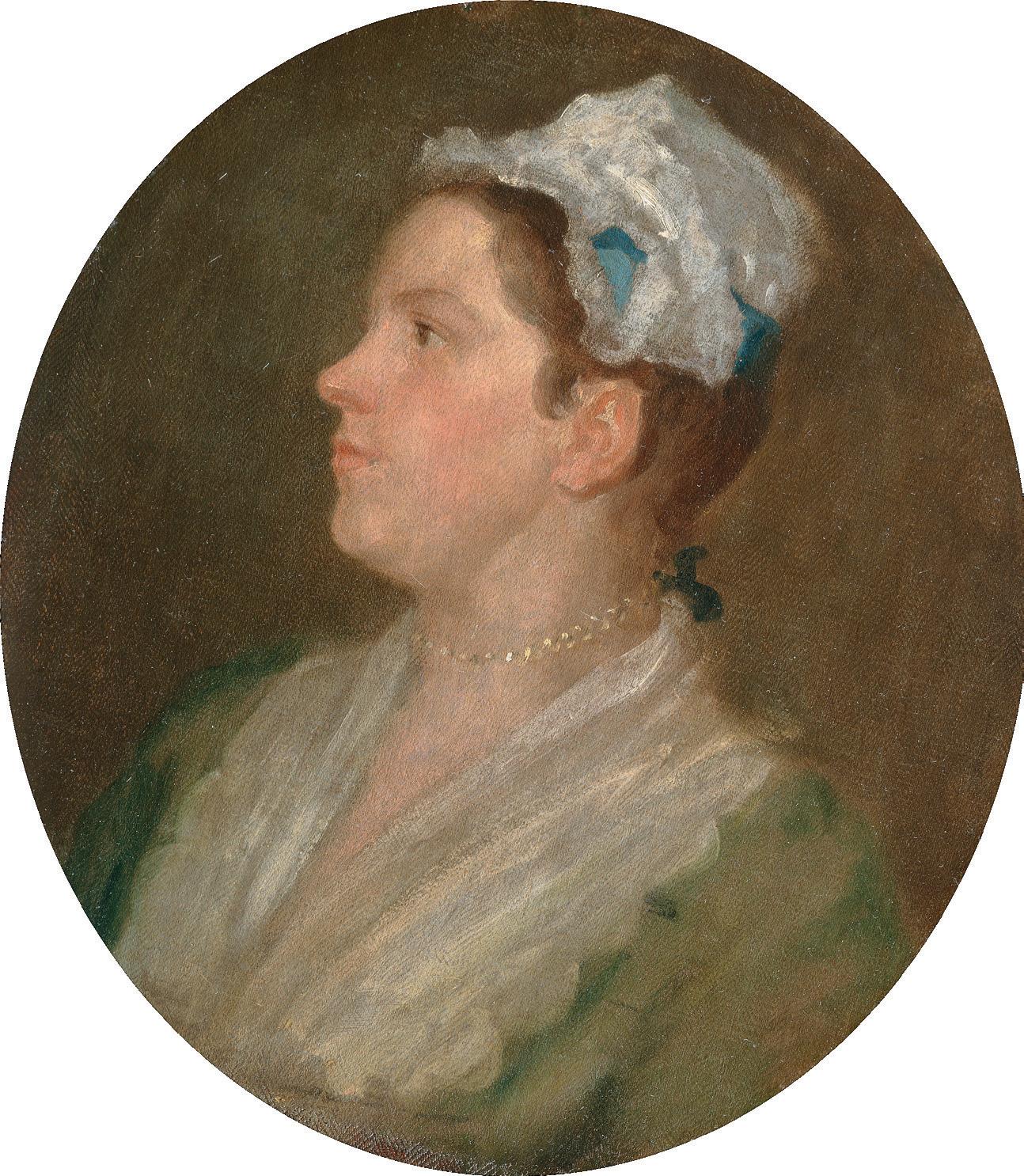
words of a painter and engraver who had achieved significant commercial and professional success, succeeding eventually even to the role of Sergeant-painter to the King (a role he had long coveted when it had belonged to his father-in-law James Thornhill and then in succession to his considerably less talented son John Thornhill). But they were the words, too, of someone who had been bruised and beaten by professional struggles, who had seen his printed designs pirated and others profiting by them, who had been publicly abused by fellow artists and sniped at by critics and driven to an embittered isolation in his final years. They reveal someone who had always been acutely aware of the vulnerabilities of the professional artist, at least any artist who had to make his living on the open marketplace with little in the way of personal favour or social status to assist him. The raw economics of the artist’s life are here exposed explicitly, precarity pinpointed as the condition for any creative existence in the context of a selfish and corrupted age. These comments come from a manuscript published in its original form only in the late 1960s, carefully edited by Michael Kitson under the title ‘Apology for Painters’. The autobiographical elements of the same disorderly
Opposite: Ann Hogarth, c. 1740. The artist’s two younger sisters, Mary and Ann, sold ready-made clothing from the Old Frock Shop in the City of London
martin myrone
body of material, extracted by Ireland and held mainly by the British Library (a few sheets found their way elsewhere), had already been published in 1955 by Joseph Burke as an appendix to his scholarly edition of Hogarth’s theoretical work of 1753, The Analysis of Beauty. Together with the drafts of the Analysis, also in the British Library, all these manuscript materials had originally been owned and used by John Ireland. Although by no means a cohesive, or even especially coherent, body of materials, they together constitute an extended reflection by the artist on the nature of artistic work in the jostling, competitive, fraught but also exciting and rapidly expanding eighteenth-century world of art that Hogarth had experienced over the previous five decades. If these themes are at other times expressed in generalised or abstracted form, and if Hogarth repeatedly turns to more generic reflection about the nature of art and the powers of observation, it is with his own life experience that these issues are brought down to earth, made concrete and most comprehensible. It is this reflective context that is crucial to our interpretation of Hogarth’s autobiography, even if it is lost somewhat when Ireland tidied up the autobiographical notes into a generally more conventional life narrative.
Ireland, nonetheless, did a great service to readers by organising Hogarth’s notes as he did. The life story set
out by Hogarth himself has been widely in use since it first appeared in print at the end of the eighteenth century. Ireland was an admirer of Hogarth, acquiring from Mrs. Mary Lewis of Chelsea, executrix of Hogarth’s widow’s will, a collection of prints, engraved copperplates and the bundled manuscripts. His Hogarth Illustrated (1791; second edition 1793; third 1806) sketched out the artist’s career and provided extensive commentary on his prints. A Supplement to Hogarth Illustrated (1798), a third volume of Hogarth Illustrated, comprised the manuscript materials, including the autobiographical notes, providing a foundation for modern scholarship on the artist. The Supplement appeared in a second edition in 1804, and the autobiography appeared in J. B. Nichols’ Anecdotes of William Hogarth written by himself; With essays on his life and genius, and criticisms on his works, selected from Walpole, Gilpin, J. Ireland, Lamb, Phillips, and others (1833) which provides the materials for a ‘reception history’ of an artist by then being installed as a English Old Master, even a ‘national treasure’ (the famous selfportrait with his pug, Trump, had been purchased by the nascent National Gallery in 1824). There were various republications and quotations over the next century, until the editions based on the manuscripts mentioned above, and the useful modern printing of Nichols’ Anecdotes (1970) with an introduction by Ronald Lightbown.
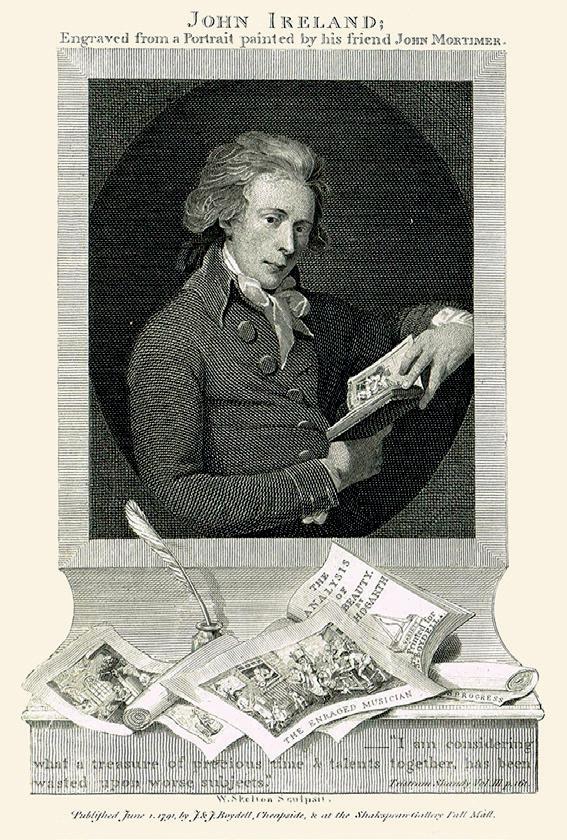
John Ireland, reading his book on Hogarth and with Hogarth’s works on the plinth below; frontispiece to Hogarth Illustrated, in a print by W. Skelton after John Hamilton Mortimer, 1791
Ireland was a professional biographer who knew his craft well. As a friend of Thomas Gainsborough and John Hamilton Mortimer, he also knew artists and the art world. He was, as Kitson notes, ‘a careful editor’ of the manuscripts left by the painter, and he did ‘his best to reproduce Hogarth’s meaning’. Readers have found in Hogarth’s own words affirmations of the pugnaciousness, critical intelligence and common sense that are
otherwise to be extrapolated from the sometimes abstruse theoretical reflection of the Analysis or encoded in his printed and painted images. But the raw text of Hogarth’s original was rendered ‘bland’ (Kitson’s term) by Ireland, at the same time as being made more lucid. Hogarth was born, he noted himself, and Ireland relates, ‘in the City of London’ on 10 November 1697, and he was baptised on 28 November in that same year. Hogarth had in fact ingeniously omitted the dates from the manuscript, so Ireland supplied them. Ireland followed Hogarth, though, in providing the key statement about his family background, put originally in the third person: ‘His Fathers Pen like that of many other authors was incapable of more than putting him in a way to shift for himself’. Hogarth’s father, Richard Hogarth, was an author and schoolmaster, who had indeed struggled to make ends meet from his writing and had, moreover, been undone and imprisoned for debt in 1712 after the failure of a coffee-house whose habitués were obliged to speak Latin. If that later project seems to us a selfevidently ill-advised commercial venture, Hogarth drew attention instead to the ‘cruel treatment he met with from Bookseller and Printers particularly in the affairs of a lattin Dictionary’ which never appeared before his untimely death in 1718. Hogarth was indeed left ‘shifting for myself’, without the option of a university education
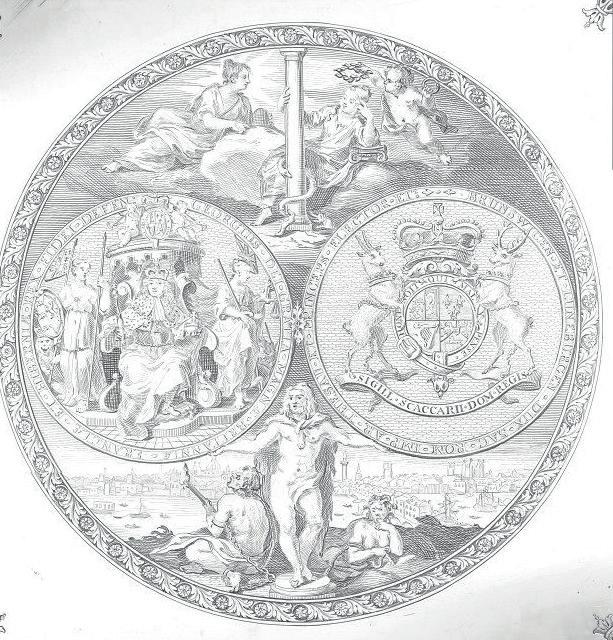
Detail from a piece of silver thought to have been engraved by Hogarth: The Walpole Salver, 1728-29, by Paul de Lamerie
or professional career that a more successful schoolmaster’s son might have anticipated. He was apprenticed instead to a silver engraver. In the muddled manuscript notes he returns several times to the point, aged twenty or twenty-three or twenty-four (all these ages are stated), that he turned instead to more inventive art, to an innovative form of portrait painting with ‘figures from 10 to 15 inches high’, to ‘the grand stile of history painting’ and the ‘Modern moral subject’. He accounts for his time to that date as ‘lost … in business that was rather detrimentall to the arts of Painting and Engraving’.
Although Hogarth does not present it in these terms, he was arguably fortunate to have developed such aspirations at a moment of commercial opportunity in Britain. Without the formal hierarchies of the continental academic system, but without, too, much in the way of patronage from monarchy, state or church, artists in the burgeoning metropolis of London were finding novel ways to make money from art. Political stability, the (relative) lack of war, liberty of the press and the proliferation of satire and criticism, together with the rapid expansion of middle-class audiences and the market for images, all conspired to create a situation that Hogarth and others were able to exploit in several ways: with new forms of portrait painting that articulated the more modest, good-humoured values of the emerging social world; with narrative and theatrical pictures that provided entertainment and a certain degree of moral education; and, crucially, with the engraved prints reproducing such pictures which could profitably disseminate an artist’s ideas and identity at a speed and across a social spectrum that was unprecedented. In the summary words of Ronald Paulson, the scholar whose biography and catalogue of prints are foundation stones for present-day Hogarth scholarship, ‘The burden of the autobiography is that he was self-taught, a tradesman, a patriotic Englishman: he was a champion
The Graham Children, 1742. This group portrait shows the family of Daniel Graham, apothecary to George I and George II
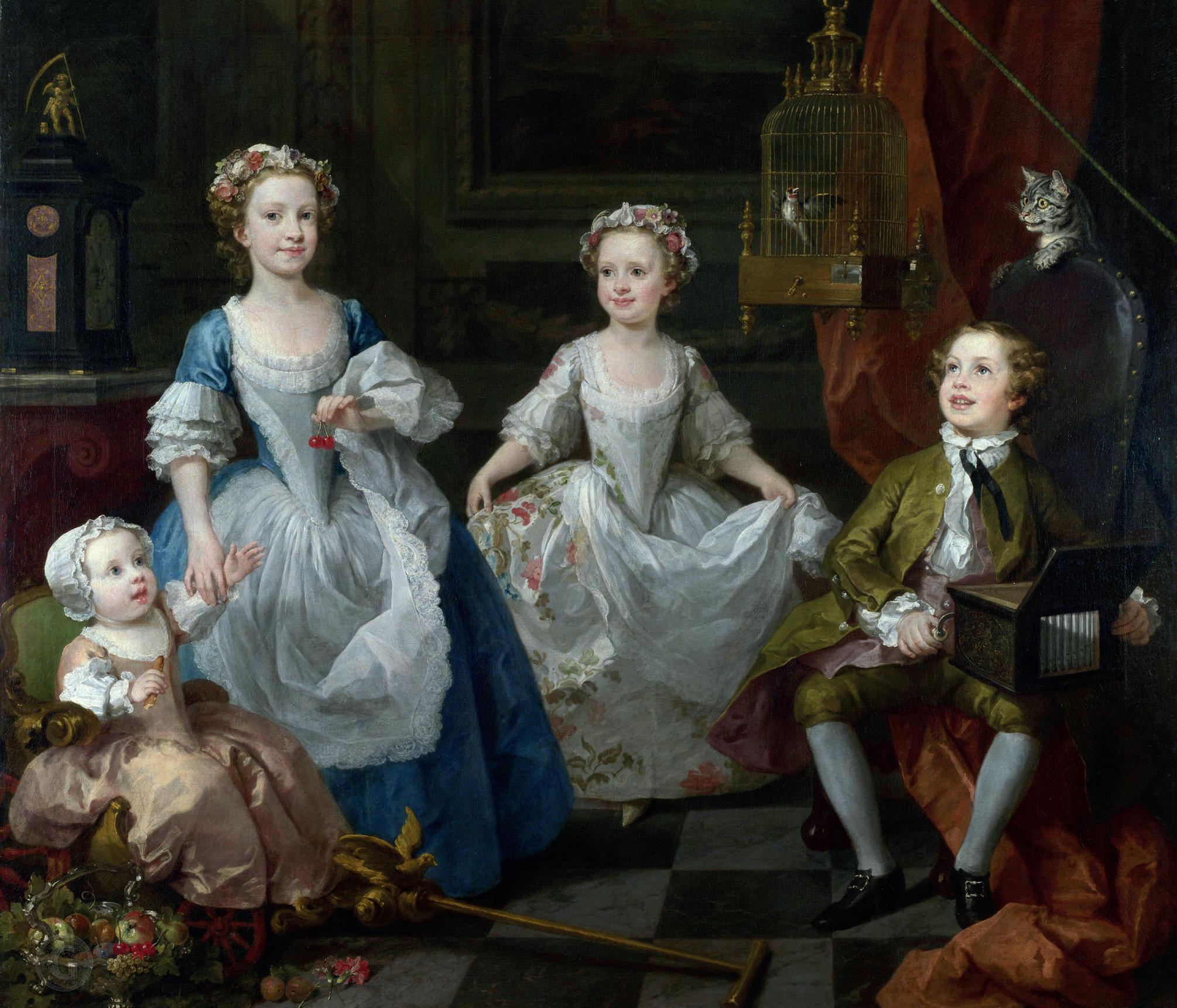

martin myrone
of liberty and the individual against printsellers, pirates, connoisseurs, and political extremists’. Hogarth opposes what we might label ‘book learning’ and insists instead upon native talents and the innate powers of observation whose possession might be an accident of birth but whose consummation depended upon ‘Encouragement and opportunity’. These themes are apparent in Ireland’s rendering of the autobiography, but are even more vivid in the theoretical digressions and reflections upon the art world that punctuate the original manuscript so untidily. Generally smoothed out to facilitate the presentation of a more linear life story, Hogarth’s text is made by Ireland to conform – to a point – to the emerging norms of the writing of artists’ lives. These were arguably less sensitive to the social and economic contingencies that run through Hogarth’s commentary on his emergence as an artist. He rejects the idea that ‘a man must be born a Painter’, as if genius were a mere accident. The artist is, in his account, socially produced, with whatever innate talent he may be equipped with sharpened, blunted or misdirected according to circumstances.
Thus it is that Hogarth’s narrative, even in Ireland’s rendering, may seem to the modern reader rather lopsided and errant in some regards. It is a ‘progress’, full of ups and more downs, leading ultimately to disappointment rather than fulfilment. But as the literary scholar Karen
Junod notes, the texts ‘focused on Hogarth’s professional achievements as a painter and engraver, but failed to provide what most eighteenth-century biographers were keen to offer: personal anecdotes about the painter’s life’. He spends longer than we might expect ruminating upon his background and youth and is surprisingly frank about the wasted years of his youth before he ventured out as a painter and designer. He is unexpectedly direct about his technical limitations as an engraver and his shortcomings as a painter of portraits. He gives a great deal of space and energy to his frustrations with printsellers, picture-dealers and publishers, and especially with the proposals for a formal art academy from among fellow-artists which seemed to him to risk putting British art on an entirely wrong footing, driven by pretensions to excel and theoretical notions rather than an engagement with life as it is lived and the production of paintings that spoke to the experience of the present. He takes time to take a swipe at the now almost forgotten French portrait painter Jean-Baptiste Vanloo, and dwells upon the illfated production of a history painting, Sigismunda (1759, Tate) which brought him public embarrassment at the end of his life. His history paintings for St Bartholomew’s Hospital are given prominence, and the argument with the urbane Scottish portrait painter Allan Ramsay set out in full, with Hogarth’s pride in his triumphant portrait
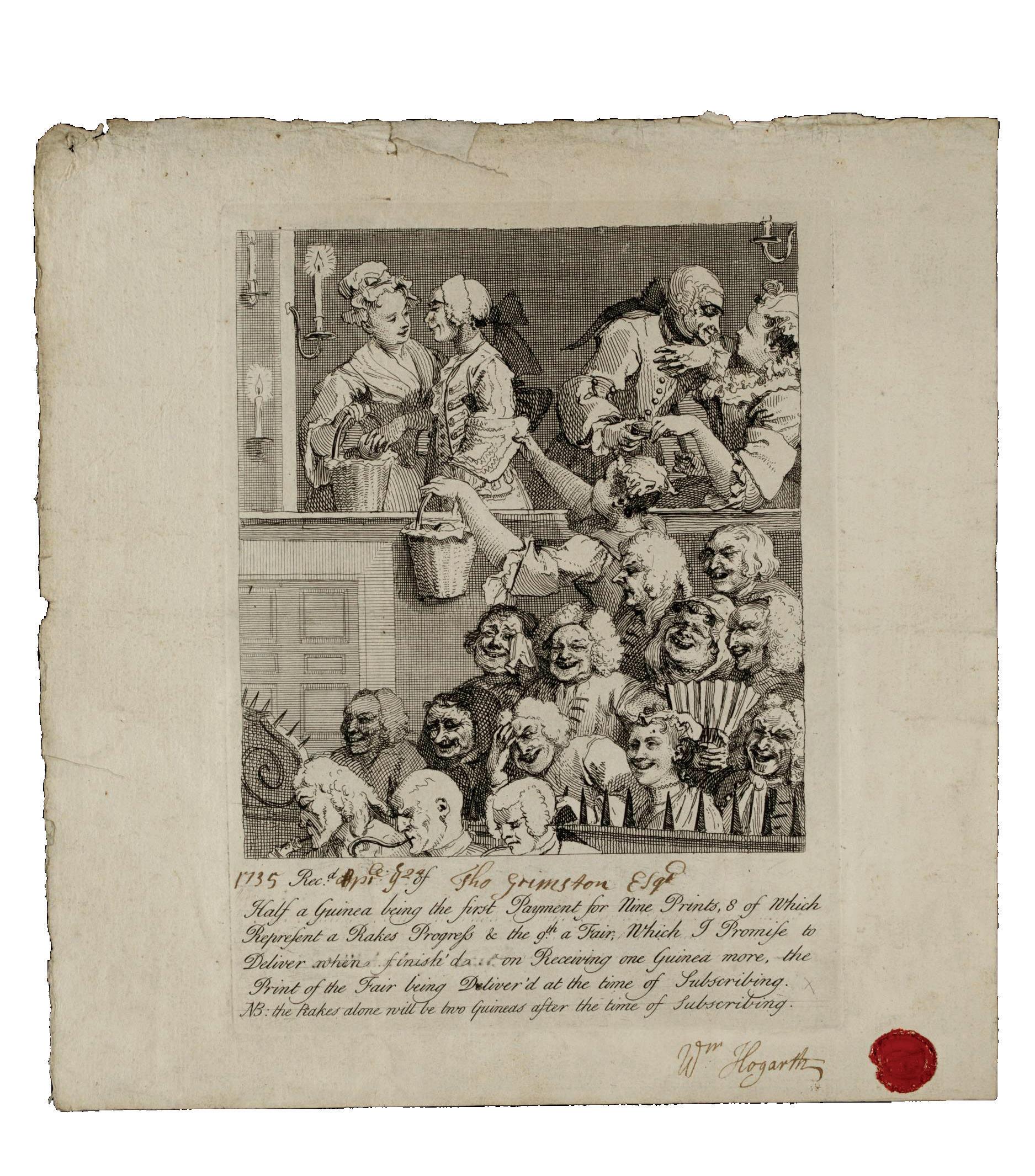
The Laughing Audience, 1733, used as a subscription ticket for the series of engravings, A Rake’s Progress, and for the print of Southwark Fair
of Captain Coram a centrepiece of the narrative. Yet the modern moral series – A Harlot’s Progress, A Rake’s Progress and Marriage A-la-Mode, which are now emphatically considered his central achievement as an artist and his major contribution to Western art history – are curiously de-emphasised in the autobiography (the commentaries on individual prints provides some degree of compensation, but not a great deal). Hogarth the social critic, the observer of London life, the scathing chronicler of prostitutes and low-life types and the corrupt in high-life, is scarcely to be distinguished in the account of the painter as a necessarily improvising observer of nature, driven to innovate by financial necessity and personal shortcomings, continually aspiring to paint history and be recognised as an authentic talent. In these respects, Hogarth may appear to be an untrustworthy witness to his own capabilities. But his insistence on struggle and failure, and his emphasis on the material influence of professional disputes and commercial realities, remain refreshingly direct and cut through much of the deception and disingenuity that emerged as stock features of artistic biography in the Romantic era. There are, without doubt, pessimism and disappointment in play when Hogarth wrote these words, which may be distracting. But he also demonstrates an unusually sharp understanding of the emerging realities of the modern
A Rake’s Progress, Plate 1, 1735. Tom Rakewell comes into his inheritance
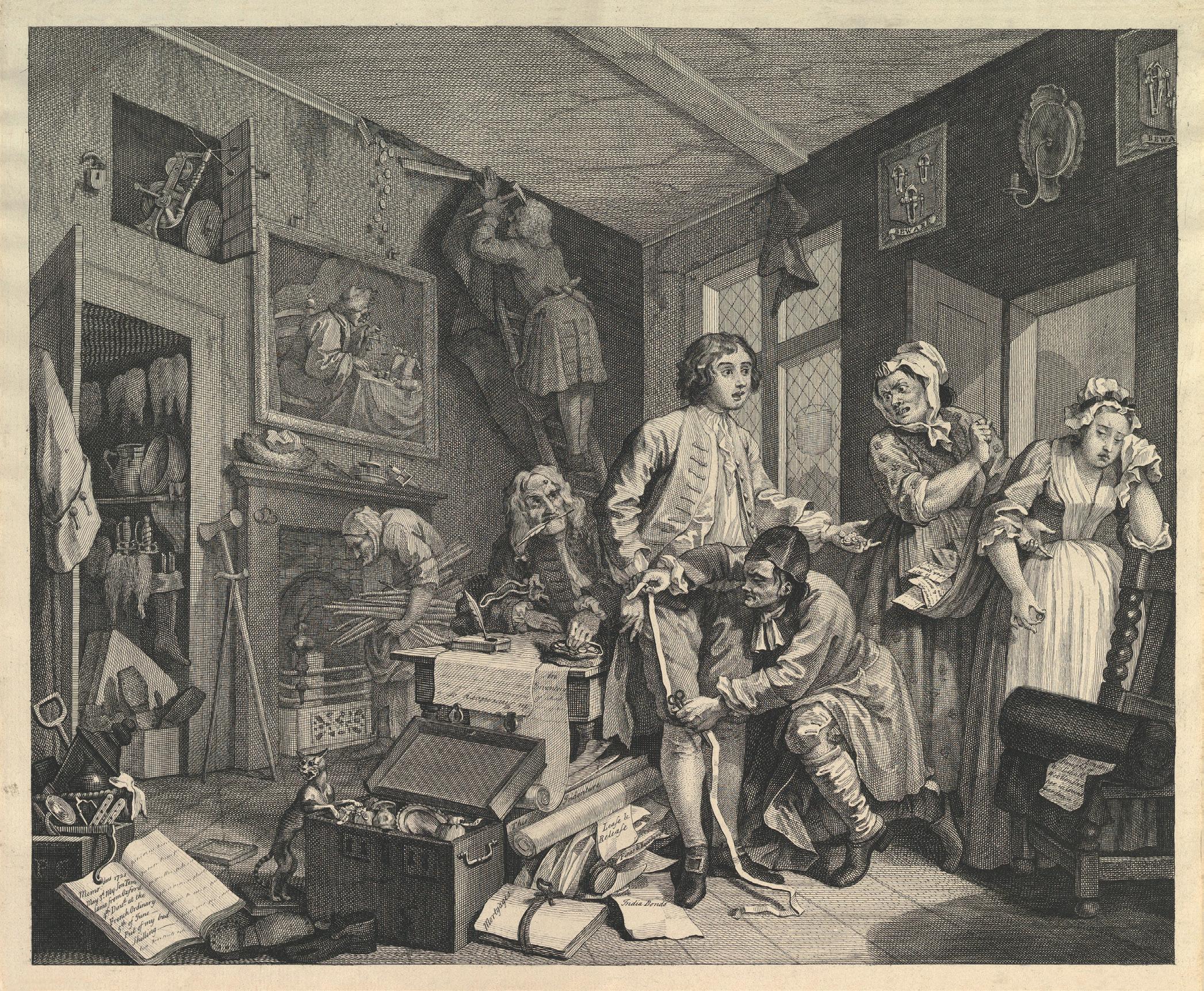

art world, both as a place of brutal commercial competition and professional rivalry, and an environment where the ‘bewitching’ nature of art was renewed sufficiently to inspire the kind of resilience, innovation and passion that are so apparent in Hogarth’s life and art – and in his autobiographical musings.
some further reading
David Bindman, William Hogarth, London, 1981
Joseph Burke, ed., William Hogarth: The Analysis of Beauty; With the Rejected Passages from the Manuscript Drafts and Autobiographical Notes, Oxford, 1955
Mark Hallett and Christine Riding, eds., Hogarth, exhibition catalogue, Tate Britain, London, 2006
Karen Junod, ‘Writing the lives of painters’: Biography and artistic identity in Britain, 1760-1810, Oxford, 2011
Michael Kitson, ‘Hogarth’s “Apology for Painters”’, The Walpole Society, vol. 41 (1966), pp. 46–111
Ronald Paulson, Hogarth, 3 vols, New Brunswick and New Jersey, 1991-93
Ronald Paulson, ed., William Hogarth: The Analysis of Beauty, New Haven and London, 1997
Marcia Pointon, William Hogarth’s Sigismunda in focus, London, 2000
EDITED BY JOHN IRELAND
The texts reproduced here are taken from eighteenthcentury publications, and we have tried to stay close to the original wording, punctuation and layout. Some vocabulary and turns of phrase may be unfamiliar to readers today, but the price of over-modernisation is to make the texts less authentic, and less illuminating as a window onto the past. This is especially true for the rough and ready writings of William Hogarth, even as presented by their faithful contemporary editor, John Ireland. Ireland wanted to help the reader by turning the painter’s crude jottings into some kind of continuous prose, without altogether losing the flavour of Hogarth’s sturdy character, and as far as possible we have respected his transcription. The chapter summaries are by Ireland, as are his occasional interventions in the text (shown here in italics), and some of the notes (as indicated).
Hogarth’s own account of his birth and early education; reasons for his being apprenticed to a silver-plate engraver; with which employment becoming disgusted, he commences an engraver on copper; his method of study; the fate of the first print he published
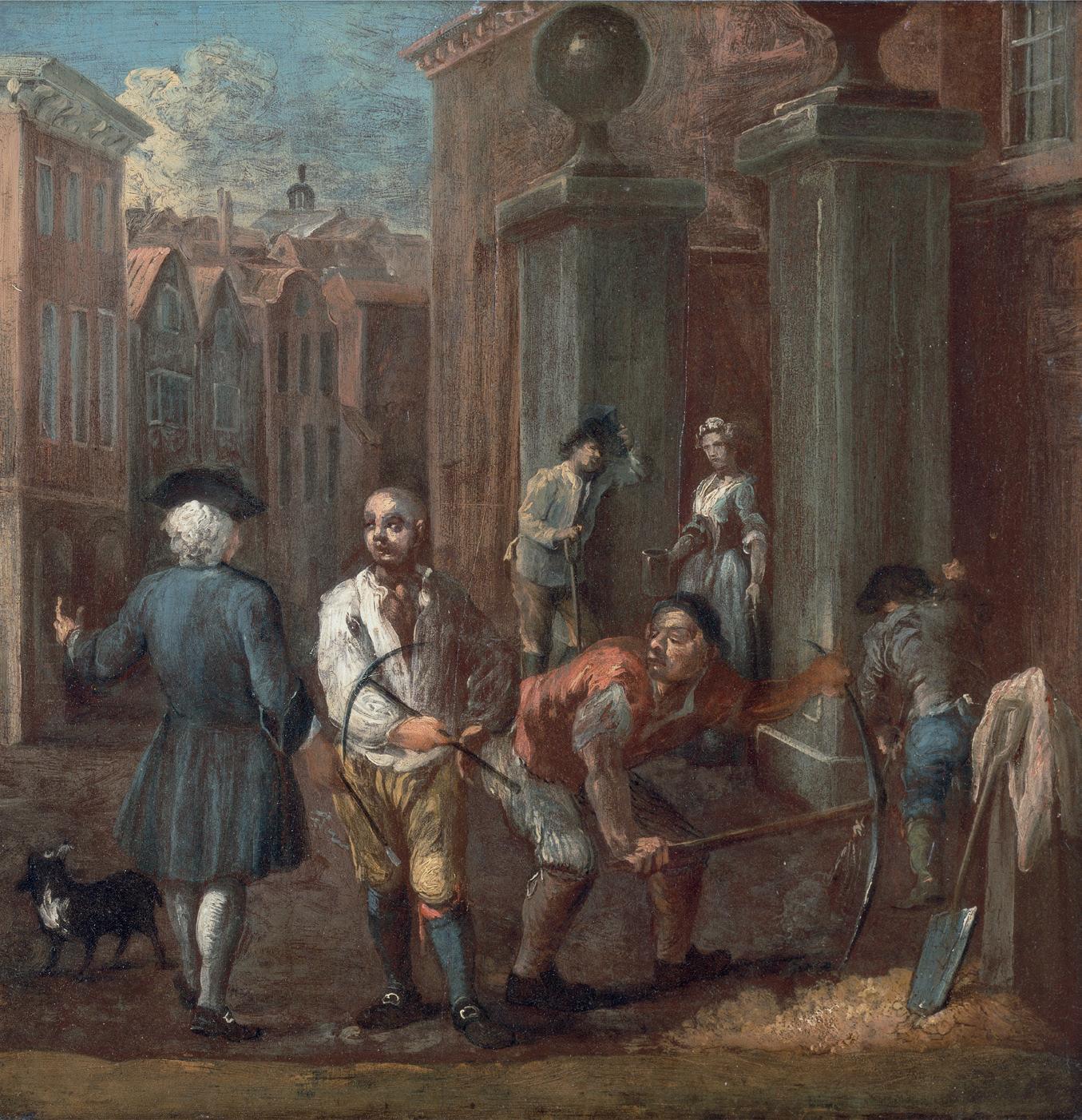

Iwas born in the City of London, on the 10th day of November 1697, and baptized the 28th of the same month. My father’s pen, like that of many other authors, did not enable him to do more than put me in a way of shifting for myself. As I had naturally a good eye, and a fondness for drawing, shows of all sorts gave me uncommon pleasure when an infant; and mimicry, common to all children, was remarkable in me. An early access to a neighbouring painter, drew my attention from play; and I was, at every possible opportunity, employed in making drawings. I picked up an acquaintance of the same turn, and soon learnt to draw the alphabet with great correctness. My exercises when at school were more remarkable for the ornaments which adorned them than for the exercise itself. In the former I soon found that blockheads with better memories could much surpass me; but for the latter, I was particularly distinguished.
Besides the natural turn I had for drawing rather than learning languages, I had before my eyes the
Opposite: Attributed to Hogarth, Sign for a Paviour, c. 1725. According to his pupil Philip Dawes, Hogarth considered the work of sign painters as ‘specimens of genius emanating from a school, which he used emphatically to observe, was truly English’.
william hogarth
precarious situation of men of classical education. I saw the difficulties under which my father laboured, and the many inconveniences he endured, from his dependance being chiefly on his pen, and the cruel treatment he met with from booksellers and printers, particularly in the affair of a Latin Dictionary,* the compiling of which had been a work of some years. It was deposited, in confidence, in the hands of a certain printer, and, during the time it was left, letters of approbation were received from the greatest scholars in England, Scotland, and Ireland. But these flattering testimonies from his acquaintance (who, as appears from their letters, which I have still by me, were of the first class), produced no profit to the author. It was therefore very conformable to my own wishes that I was taken from school, and served a long apprenticeship to a silver-plate engraver.
I soon found this business in every respect too limited. The paintings of St Paul’s Cathedral and
* The Dictionary here alluded to, Mrs. Lewis, of Chiswick, presented to me. It is a thick quarto, containing an early edition of Littleton’s Dictionary, and also Robertson’s Phrases; with numerous corrections to each, and about 400 pages of manuscript close written. On the marginal leaf is inscribed, in Hogarth’s hand-writing: “The manuscript part of this Dictionary was the work of Mr. Richard Hogarth.”—Note by J. Ireland
anecdotes of william hogarth
Greenwich Hospital, which were at that time going on, ran in my head; and I determined that silver-plate engraving should be followed no longer than necessity obliged me to it. Engraving on copper was, at twenty years of age, my utmost ambition. To attain this it was necessary that I should learn to draw objects something like nature, instead of the monsters of heraldry, and the common methods of study were much too tedious for one who loved his pleasure, and came so late to it; for the time necessary to learn in the usual mode, would leave me none to spare for the ordinary enjoyments of life. This led me to considering whether a shorter road than that usually travelled was not to be found. The early part of my life had been employed in a business rather detrimental than advantageous to those branches of the art which I wished to pursue, and have since professed. I had learned, by practice, to copy with tolerable exactness in the usual way; but it occurred to me that there were many disadvantages attending this method of study, as having faulty originals, &c. and even when the pictures or prints to be imitated were by the best masters, it was little more than pouring water out of one vessel into another. Drawing in an academy, though it should be after the life, will not make the student an artist; for as the eye is often taken from the original, to draw a bit at a time, it
is possible he may know no more of what he has been copying, when his work is finished, than he did before it was begun. There may be, and I believe are, some who, like the engrossers of deeds, copy every line without remembering a word; and if the deed should be in law Latin, or old French, probably without understanding a word of their original. Happy is it for them; for to retain would be indeed dreadful. A dull transcriber, who in copying Milton’s “Paradise Lost” hath not omitted a line, has almost as much right to be compared to Milton, as an exact copier of a fine picture by Rubens hath to be compared to Rubens. In both cases the hand is employed about minute parts, but the mind scarcely ever embraces the whole. Besides this, there is an essential difference between the man who transcribes the deed, and he who copies the figure; for though what is written may be line for line the same with the original, it is not probable that this will often be the case with the copied figure; frequently far from it. Yet the performer will be much more likely to retain a recollection of his own imperfect work than of the original from which he took it.
More reasons, not necessary to enumerate, struck me as strong objections to this practice, and led me to wish that I could find the shorter path,—fix forms and characters in my mind, and, instead of copying the
anecdotes of william hogarth
lines, try to read the language, and if possible find the grammar of the art, by bringing into one focus the various observations I had made, and then trying by my power on the canvas, how far my plan enabled me to combine and apply them to practice.
For this purpose, I considered what various ways, and to what different purposes, the memory might be applied; and fell upon one which I found most suitable to my situation and idle disposition.
Laying it down first as an axiom, that he who could by any means acquire and retain in his memory, perfect ideas of the subjects he meant to draw, would have as clear a knowledge of the figure, as a man who can write freely hath of the twenty-four letters of the alphabet, and their infinite combinations (each of these being composed of lines), and would consequently be an accurate designer. This I thought my only chance for eminence, as I found that the beauty and delicacy of the stroke in engraving was not to be learnt without much practice and demanded a larger portion of patience than I felt myself disposed to exercise. Added to this, I saw little probability of acquiring the full command of the graver, in a sufficient degree to distinguish myself in that walk; nor was I at twenty years of age, much disposed to enter on so barren and unprofitable a study, as that of merely making fine
william hogarth
lines. I thought it still more unlikely, that by pursuing the common method, and copying old drawings, I could ever attain the power of making new designs, which was my first and greatest ambition. I therefore endeavoured to habituate myself to the exercise of a sort of technical memory; and by repeating in my own mind, the parts of which objects were composed, I could by degrees combine and put them down with my pencil. Thus, with all the drawbacks which resulted from the circumstances I have mentioned, I had one material advantage over my competitors, viz. the early habit I thus acquired of retaining in my mind’s eye, without coldly copying it on the spot, whatever I intended to imitate.* Sometimes, but too seldom, I took the life, for correcting the parts I had not perfectly enough remembered, and then I transferred them to my compositions.
My pleasures and my studies thus going hand in
* Though averse, as he himself expresses it, to coldly copying on the spot any objects that struck him, it was usual with him when he saw a singular character, either in the street or elsewhere, to pencil the leading features, and prominent markings upon his nail, and when he came home, to copy the sketch on paper, and afterwards introduce it in a print. Several of these sketches I have seen, and in them may be traced the first thoughts for many of the characters which he afterwards introduced in his works.—Note by John Ireland.
anecdotes of william hogarth
hand, the most striking objects that presented themselves, either comic or tragic, made the strongest impression on my mind; but had I not sedulously practised what I had thus acquired, I should very soon have lost the power of performing it.
Instead of burdening the memory with musty rules, or tiring the eyes with copying dry and damaged pictures, I have ever found studying from nature the shortest and safest way of attaining knowledge in my art.* By adopting this method, I found a redundancy of matter continually occurring. A choice of composition was the next thing to be considered, and my constitutional idleness naturally led me to the use of such materials as I had previously collected; and to this I was further induced by thinking, that if properly combined, they might be made the most useful to society in painting, although similar subjects had often failed in writing and preaching.
To return to my narrative,—the instant I became master of my own time, I determined to qualify
* As this was the doctrine I preached as well as practised, an arch brother of the pencil once gave it this turn; that the only way to draw well, was not to draw at all; and on the same principle, he supposed, that if I wrote an essay on the art of swimming, I should prohibit my pupil from going into the water, until he had learnt.
myself for engraving on copper. In this I readily got employment; and frontispieces to books, such as prints to Hudibras, in twelves, &c. soon brought me into the way. But the tribe of booksellers remained as my father had left them, when he died about five years before this time, which was of an illness occasioned partly by the treatment he met with from this set of people, and partly by disappointment from great men’s promises; so that I doubly felt this usage, which put me upon publishing on my own account. But here again I had to encounter a monopoly of printsellers, equally mean, and destructive to the ingenious; for the first plate I published, called The Taste of the Town in which the reigning follies were lashed, had no sooner begun to take a run, than I found copies of it in the print-shops, vending at half-price, while the original prints were returned to me again; and I was thus obliged to sell the plate for whatever these pirates pleased to give me, as there was no place of sale but at their shops.
Opposite: The Taste of the Town, 1724. The banner shows a group of English noblemen entreating an Italian singer to perform in London; she rakes in their money. Crowds go to masquerades and commedia dell’ arte while a waste paper hawker trundles a barrow full of the works of Shakespeare, Dryden and others. In the background three virtuosi admire Lord Burlington’s Italianate gateway, labelled ‘Accademy of Arts’
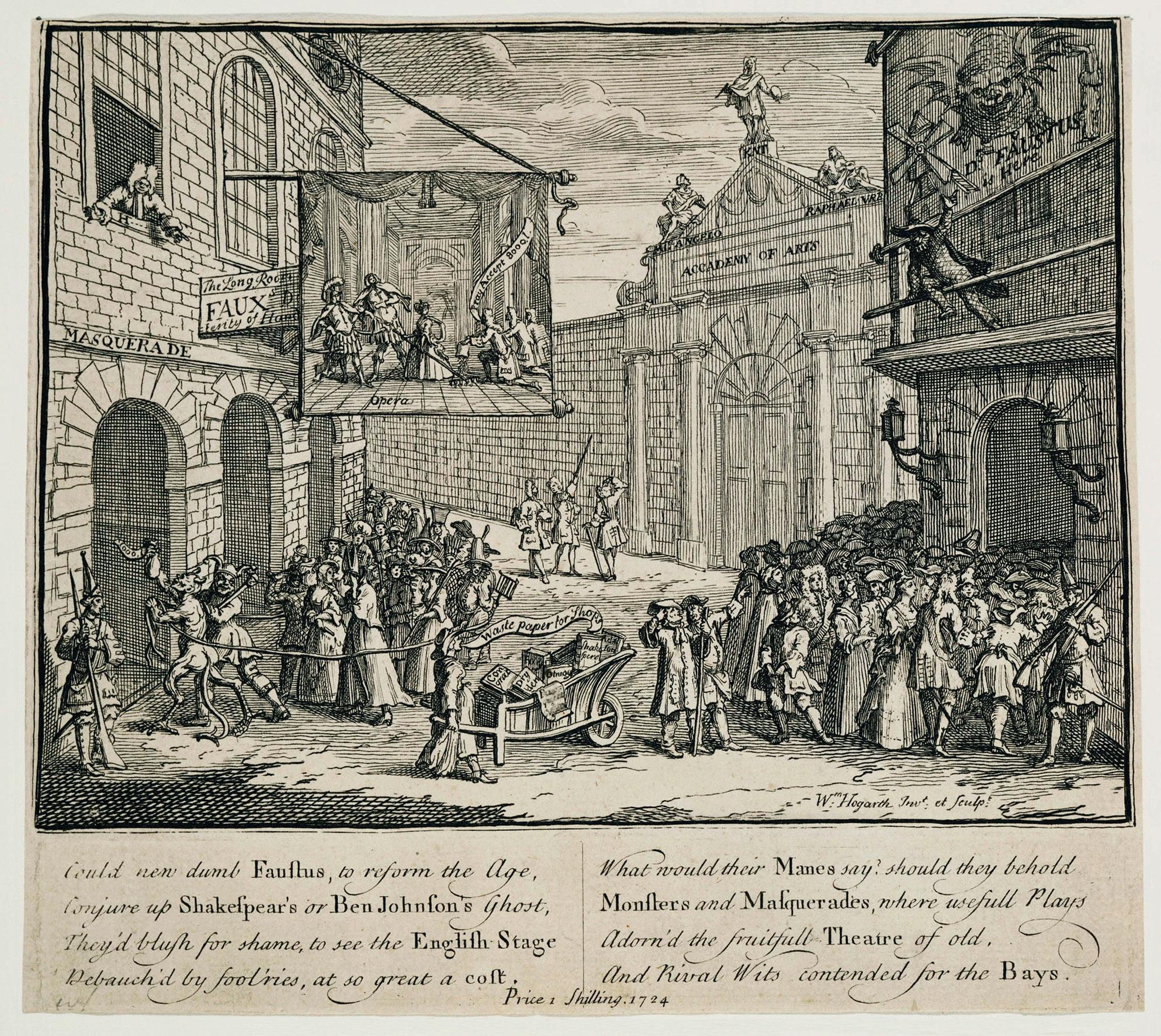

invariably to make those about me tolerably happy, and my greatest enemy cannot say I ever did an intentional injury; though, without ostentation, I could produce many instances of men that have been essentially benefited by me. What may follow, God knows. finis
written by hogarth
edited by john ireland
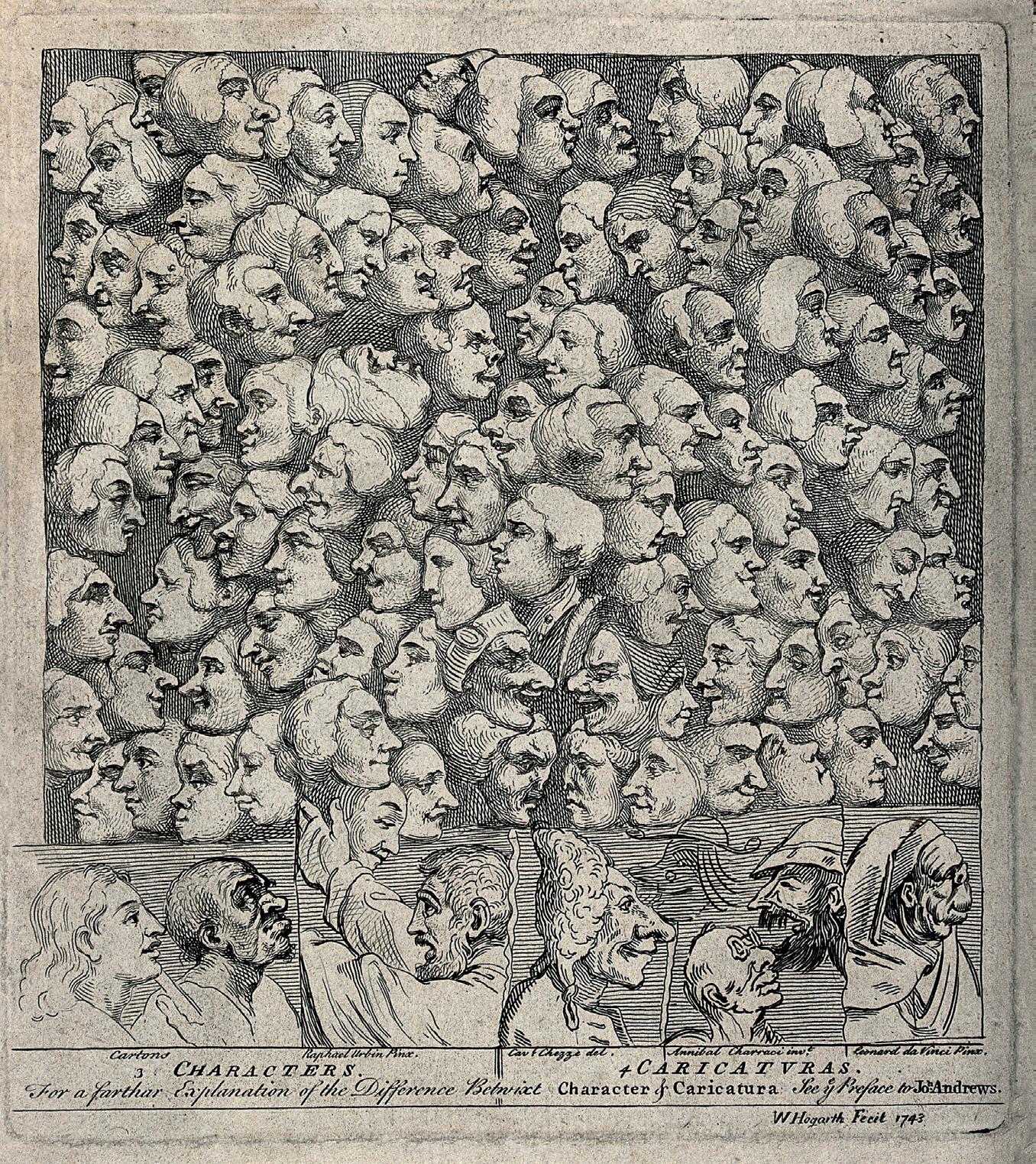

characters and caricaturas
Being perpetually plagued, from the mistakes made among the illiterate, by the similitude in the sound of the words character and caricatura, I ten years ago endeavoured to explain the distinction by the above print; and as I was then publishing Marriage à-la-Mode, wherein were characters of high life, I introduced the great number of faces there delineated, (none of which are exaggerated) varied at random, to prevent if possible personal application, when the prints should come out:
We neither this nor that Sir Fopling call. He’s knight o’ th’ shire, and represents you all.
This, however, did not prevent a likeness being found for each head, for a general character will always bear some resemblance to a particular one.
industry and idleness
Industry and Idleness, exemplified in the conduct of two fellow-prentices; where the one, by taking good courses, and pursuing those points for which he was put apprentice, becomes a valuable man, and an
Opposite: Characters and Caricaturas, 1743
Overleaf: Plate 10 of Industry and Idleness, 1747
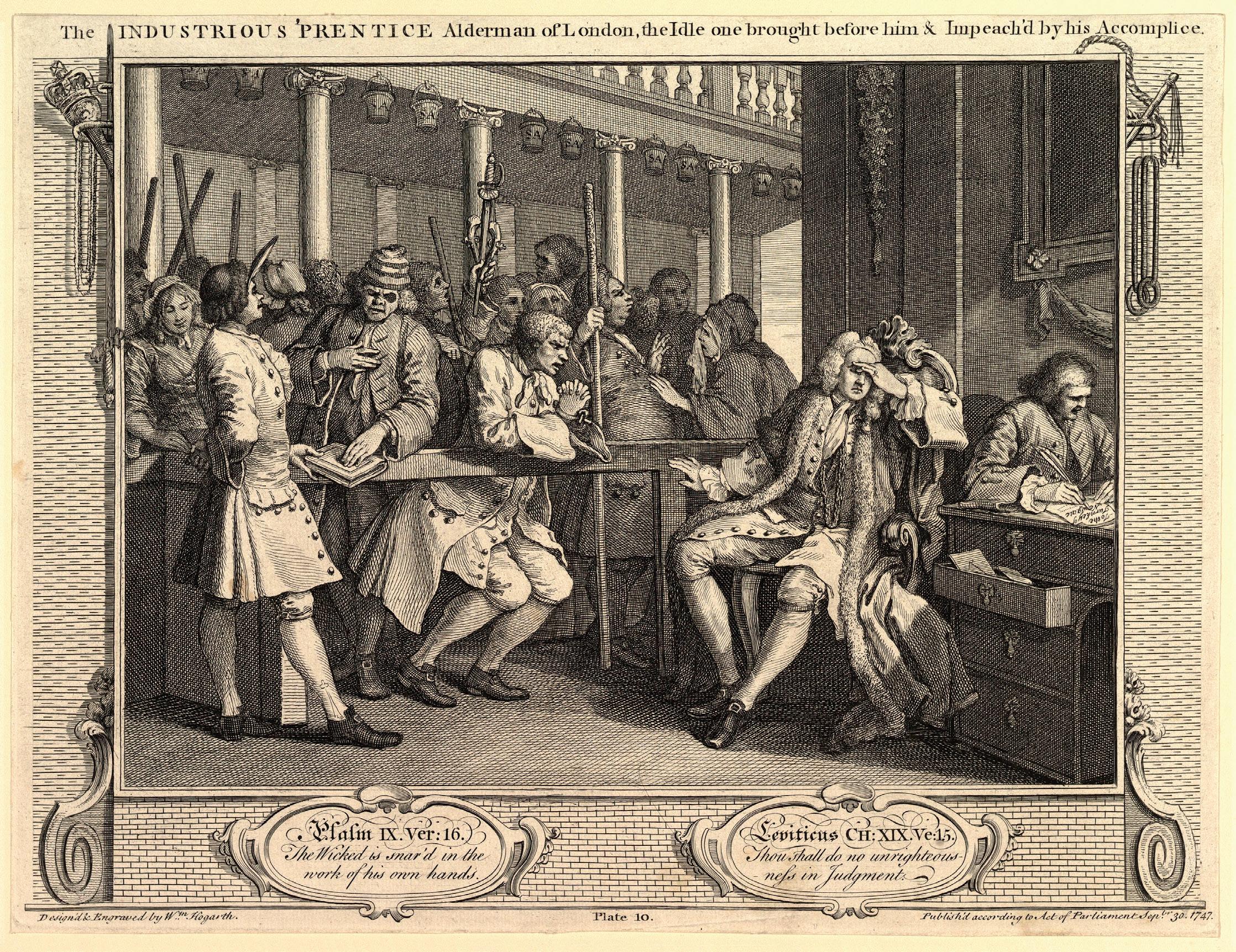

ornament to his country; whilst the other, giving way to idleness, naturally falls into poverty, and most commonly ends fatally, as is expressed in the last print. As these prints were intended more for use than ornament, they were done in a way that might bring them within the purchase of those whom they might most concern; and, lest any part should be mistaken, a description of each print is engraved thereon. Yet, notwithstanding the inaccuracy of the engraving, what was thought conducive and necessary for the purpose for which they were intended, such as action and expression, &c, are as carefully attended to, as the most delicate strokes of the graver would have given, sometimes more; for often expression, the first quality in pictures, suffers in this point, for fear the beauty of the stroke should be spoiled; while the rude and hasty touch, when the fancy is warm, gives a spirit not to be equalled by high finishing.
These twelve prints were calculated for the instruction of young people, and everything addressed to them is fully described in words as well as figures; yet to foreigners a translation of the mottoes, the intention of the story, and some little description of each print, may be necessary. To this may be added, a slight account of our customs, as boys being usually bound for seven years, &c. Suppose the whole story was made
remarks on various prints
into a kind of tale, describing in episode the nature of a night-cellar, a marrow-bone concert, a Lord Mayor’s show, &c. These prints I have found sell much more rapidly at Christmas than at any other season.
After the March to Finchley, the next print that I engraved, was the Roast Beef of Old England;* which took its rise from a visit I paid to France the preceding year. The first time an Englishman goes from Dover to Calais, he must be struck with the different face of things at so little a distance, A farcical pomp of war, pompous parade of religion, and much bustle with very little business. To sum up all, poverty, slavery, and innate insolence, covered with an affection of politeness, give you even here a true picture of the manners of the whole nation; nor are the priests less opposite to those of Dover, than the two shores. The friars are dirty, sleek, and solemn; the soldiery are lean, ragged, and tawdry; and as to the fishwomen— their faces are absolute leather.
* So does he express himself in the MS. though the Roast Beef was published March 6, 1749; and the March, Dec. 31, 1750.—Note by John Ireland
william hogarth
Lord Orford has the following just observations on the series of prints which form the subject of Marriage A-la-Mode.— “An intrigue is carried on throughout the piece. He (Hogarth) is more true to character than Congreve; each personage is distinct from the rest, acts in his sphere, and cannot be confounded with any other of the dramatis personæ. The alderman’s foot-boy, in the last print, is an ignorant rustic; and if wit is struck out from the characters in which it is not expected, it is from their acting conformably to their situation, and from the mode of their passions, and not from their having the wit of fine gentlemen. Thus, there is wit in the figure of the alderman, who, when his daughter is expiring in the agonies of poison, wears a face of solicitude—but it is to save her gold ring, which he is gently drawing from her finger. The thought is parallel to Molière’s, where the miser puts out one of the candles as he is talking. Molière, inimitable as he has proved, brought a rude theatre to perfection. Hogarth had no model to follow and improve upon.”*
* Horace Walpole, 4th Earl of Orford, “Anecdotes of Painting”, in Works, vol. III, p. 453.
List of illustrations
p. 1: The Graham Children (detail), 1742, oil on canvas, 160 x 181 cm, National Gallery, London
p. 2: The Shrimp Girl, c. 1740-45, oil on canvas, 68 x 52 cm, National Gallery, London
p. 4: The Battle of the Pictures, 1745, etching, 20.8 x 21.2 cm (sheet), Metropolitan Museum of Art, New York
p. 6: Self-Portrait, c. 1735 (unfinished), oil on canvas, 55 x 51 cm, Yale Center for British Art, New Haven
p. 8: Ann Hogarth, c. 1740, oil on canvas, 46 x 41 cm, Yale Center for British Art, New Haven
p. 12: W. Skelton after John Mortimer, John Ireland, 1791, engraved frontispiece to Hogarth Illustrated, 17.4 x 11.2 cm, Metropolitan Museum of Art, New York
p. 14: Paul de Lamerie and William Hogarth, The Walpole salver (detail), 1728-29, engraving on silver, salver dimensions 48 x 48 5 cm, Victoria and Albert Museum, London
pp. 16-17: The Graham Children, 1742, oil on canvas, 160.5 x 181 cm, National Gallery, London
p. 20: The Laughing Audience, 1733, etching, 27 x 26 cm (sheet), Victoria and Albert Museum, London
pp. 22-23: A Rake’s Progress, plate 1, 1735, etching and engraving, 35.2 x 40.4 cm (sheet), Metropolitan Museum of Art, New York
p. 28: Attributed to Hogarth, Sign for a Paviour, c. 1725, oil on panel, 56 x 56 cm, Yale Center for British Art, New Haven
p. 37: The Taste of the Town, 1724, etching and engraving, 15 x 18 cm (sheet), Royal Collection, United Kingdom
p. 40: The Wedding of Stephen Beckingham and Mary Cox, 1729, oil on canvas, 128.3 x 102.9 cm, Metropolitan Museum of Art, New York
pp. 48-49: Sir Andrew Fountaine examining a painting, 1730-35, oil on canvas, 48 x 58 cm, Philadelphia Museum of Art, Philadelphia
p. 60: Captain Thomas Coram, 1740, oil on canvas, 239 x 148 cm, Foundling Museum, London
pp. 62-63: David Garrick as Richard III, c. 1745, oil on canvas, 191 x 251 cm, Walker Art Gallery, Liverpool
p. 66: Boys peeping at Nature, 1751, etching and engraving, 15 x 12.3 cm (sheet), Metropolitan Museum of Art, New York
pp. 80-81: Analysis of Beauty, plate 1, 1753, etching and engraving,
39 x 50.5 cm (plate), Metropolitan Museum of Art, New York
p. 91 Time Smoking a Picture, c. 1761, etching and aquatint, 24 x 18 cm (sheet), Metropolitan Museum of Art, New York
p. 96 Self-portrait with his pug, Trump, 1745, oil on canvas, 90 x 70 cm, Tate, London
p. 108 Self-portrait, c. 1757-58, oil on canvas, 45.1 x 42.5 cm, National Portrait Gallery, London
pp. 112-13 The Lady’s Last Stake, 1759, oil on canvas, 91 x 105 cm, Albright-Knox Art Gallery, Buffalo, NY
p. 117 Sigismunda Mourning over the Heart of Guiscardo, 1759, oil on canvas, 100 x 127 cm, Tate, London
pp. 122-23 The Times, plate 1, 1762, etching and engraving, 24.5 x 30.3 cm (sheet), Metropolitan Museum of Art, New York
p. 125 John Wilkes, 1763, etching and engraving, 36.4 x 23.4 cm (sheet, trimmed within plate), Metropolitan Museum of Art, New York
p. 127 The Bruiser (Satire on Charles Churchill), 1763, etching and engraving, 37.7 x 27 cm (sheet), Metropolitan Museum of Art, New York
p. 130 Characters and Caricaturas, 1743, etching and engraving, 23 4 x 20 9 cm (plate), Wellcome Collection, London
pp. 132-33 Industry and Idleness, plate 10, 1747, etching and engraving, 25.8 x 34.8 cm (sheet), Metropolitan Museum of Art, New York
pp. 136-37 O the Roast Beef of Old England &c., 1749, etching and engraving, 38.2 x 46 cm (sheet), Metropolitan Museum of Art, New York
p. 140 Gin Lane, 1751, etching and engraving, 38.3 x 31.7 cm (sheet), Metropolitan Museum of Art, New York
p. 141 Beer Street, 1751, etching and engraving, 42 x 34.4 cm (sheet), Metropolitan Museum of Art, New York
pp. 143-46 The Four Stages of Cruelty, 1751, etching and engraving, each plate 35.5 x 29.9 cm, Metropolitan Museum of Art, New York
pp. 148-49 An Election Entertainment, 1755, etching and engraving,
40.3 x 54.1 cm (sheet), Metropolitan Museum of Art, New York
p. 151 The Bench, 1758, etching and engraving, 30.5 x 21.2 cm (sheet), Metropolitan Museum of Art, New York
p. 153 The Five Orders of Perriwigs, 1761, etching, 30.2 x 21.9 cm (sheet), Metropolitan Museum of Art, New York
pp. 158-59 Marriage A-la-Mode: 1, The Marriage Settlement, c. 1743, oil on canvas, 70 x 91 cm, National Gallery, London
p. 163 Marriage A-la-Mode: 1, The Marriage Settlement (detail), c. 1743, oil on canvas, 70 x 91 cm, National Gallery, London
pp. 164-65 Marriage A-la-Mode: 2, The Tête-à-Tête, c. 1743, oil on canvas, 70 x 91 cm, National Gallery, London
pp. 168-69 Marriage A-la-Mode: 3, The Inspection, c. 1743, oil on canvas, 70 x 91 cm, National Gallery, London
p. 172 Marriage A-la-Mode: 3, The Inspection (detail), c. 1743, oil on canvas, 70 x 91 cm, National Gallery, London
pp. 174-75 Marriage A-la-Mode: 4, The Toilette, c. 1743, oil on canvas, 71 x 91 cm, National Gallery, London
p. 178 Marriage A-la-Mode: 4, The Toilette (detail), c. 1743, oil on canvas, 71 x 91 cm, National Gallery, London
pp. 180-81 Marriage A-la-Mode: 5, The Bagnio, c. 1743, oil on canvas, 71 x 91 cm, National Gallery, London
p. 183 Marriage A-la-Mode: 5, The Bagnio (detail), c. 1743, oil on canvas, 71 x 91 cm, National Gallery, London
pp. 184-85 Marriage A-la-Mode: 6, The Lady’s Death, c. 1743, oil on canvas, 70 x 91 cm, National Gallery, London
Illustrations pp. 1, 16-17, 96, 158-59, 163, 164-65, 168-69, 172, 174-75, 178, 18081, 183 and 184-85 Wikimedia; pp. 2, 48-49 Gallerix; on pp. 4, 12, 22-23, 40, 66, 80-81, 91, 117, 122-23, 125, 127, 132-33, 136-37, 140, 141, 143-46, 148-49, 151 and 153 Metropolitan Museum of Art, New York; pp. 6, 8 and 26 Yale Center for British Art, New Haven; p. 14 and 20 Victoria & Albert Museum, London; p. 37 Royal Collection, United Kingdom; pp. 60, 62-63 and 108 Google Arts & Culture; pp. 112-13 Albright-Knox Art Gallery; p. 117 Tate; and p. 130 Wellcome Collection